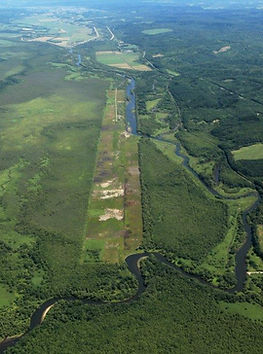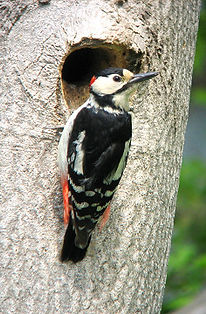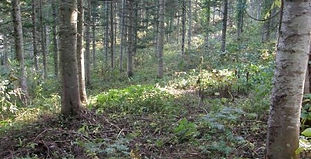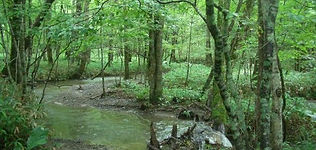Abstracts of journal articles
The conservation of raptor habitats is hypothesized to be related to the conservation of many other organisms, and raptor conservation is being performed in many locations worldwide. However, for a long time, it was unclear whether by using raptors as indicator species it was possible to conserve areas of high abundance and reproductive success of other organisms.
In this research, in the wetlands of the Tomakomai region of Hokkaido, we measured the reproductive success (number of fledglings) of the eastern marsh harrier, a wetlands raptor, for three years. Then, we examined the parent and fledgling abundances of other small birds in wetlands that varied in harrier reproductive success. In the past, it was difficult to directly measure the reproductive success of small birds over wide areas, but we overcame this problem by developing a new method of luring not only the parents but also the fledglings, by using a loudspeaker to send out alarm calls of the small birds against predators.
As a result, in wetlands where the number of harrier fledglings was high, we found that there were many parents and fledglings of several small bird species, and we successfully developed models that predict over a wide area the number of fledglings of small birds based on reproductive success of the harrier. These findings suggest that wetlands with high reproductive success of several sympatric small bird species could be conserved based on the reproductive success of the harrier.
Is Raptor Conservation Tied to the Conservation of Other Birds? —Fledgling Numbers Indicate a Link
Senzaki, M., Yamaura, Y., Nakamura, F. 2015. The usefulness of top predators as biodiversity surrogates indicated by the relationship between the reproductive outputs of raptors and other bird species. Biological Conservation 191:460-468.

photo by Masayuki Senzaki
Major decline in marine and terrestrial animal consumption by brown bears (Ursus arctos)
Matsubayashi J, Morimoto JO, Tayasu I, Mano T, Nakajima M, Takahashi O, Kobayashi K & Nakamura F. (2015) Scientific Reports 5: 9263.
(DOI: 10.1038/srep09203) http://t.co/9Af7wiV3TX
Human activities have had the strongest impacts on natural ecosystems since the last glacial period, including the alteration of interspecific relationships such as food webs. In this paper, we present a historical record of major alterations of trophic structure by revealing millennium-scale dietary shifts of brown bears (Ursus arctos) on the Hokkaido islands, Japan, using carbon, nitrogen, and sulfur stable isotope analysis. Dietary analysis of brown bears revealed that salmon consumption by bears in the eastern region of Hokkaido significantly decreased from 19% to 8%. In addition, consumption of terrestrial animals decreased from 56% to 5% in western region, and 64% to 8% in eastern region. These dietary shifts are likely to have occurred in the last approximately 100–200 years, which coincides with the beginning of modernisation in this region. Our results suggest that human activities have caused an alteration in the trophic structure of brown bears in the Hokkaido islands. This alteration includes a major decline in the marine-terrestrial linkage in eastern region, and a loss of indirect-interactions between bears and wolves, because the interactions potentially enhanced deer predation by brown bears.
Time-lagged responses of indicator taxa to temporal landscape changes in agricultural landscapes
Yamanaka, S., Akasaka, T., Yamaura, Y., Kaneko, M., Nakamura, F. (2015) Ecological Indicators 48: 593-598.
Biological indicator methods represent one of the most effective and widely used strategies for understanding the influences of environmental degradation on biodiversity in various landscapes. Researchers and land managers generally assume that the present distributions of biological indicator species are influenced by the current environment. However, recent studies have suggested the importance of past environments to species distributions (i.e., a time lag between changes in species distribution and habitat alterations). Therefore, it is necessary to understand the effects of past environments on the distributions of indicator species.
We conducted a survey on the Tokachi Plain in Hokkaido, Japan. We targeted two taxa that have been widely used as indicator species (carabid beetles and bats) and investigated whether past landscape environments influenced their present distributions. We showed that past landscape environments (5 decades prior to the present) influenced the distributions of some ecological trait groups in each taxon (large body size for carabid beetles and a 25 kHz peak echolocation frequency for bats) and that these effects varied among groups. Our results suggest the need to consider the dynamics of land-use changes and the effects of past environments on the distributions of indicator taxa, otherwise we may misunderstand the effects of environmental degradation on biodiversity.


Land sharing vs. land sparing: does the compact city reconcile urban development and biodiversity conservation?
Soga, M., Yamaura, Y., Koike, S., Gaston, K. J. (2014) Journal of Applied Ecology 51: 1378-1386
-
As cities around the world rapidly expand, there is an urgent need to implement the best development form to minimize the negative impacts of urbanization on native biodiversity. Two divergent forms for the expansion of cities are land-sharing and land-sparing developments. To date, their relative benefits for biodiversity conservation are poorly understood.
-
We quantified the relative conservation benefits of land-sharing and land-sparing developments for butterflies and ground beetles in Tokyo, Japan. For each insect species, we determined which approach resulted in a larger total population size.
-
At a higher level of urbanization (higher number of buildings in a landscape), land sparing rather than land sharing resulted in a higher total population size for the majority species of both taxa. However, at a lower level of urbanization, butterflies and ground beetles showed different responses to city development forms. Ground beetles had their highest total population sizes under land sparing, whereas for butterflies, especially open-land and matrix-dwelling species, larger populations were achieved under land sharing.
-
The negative impacts of urbanization on biodiversity differ greatly between land-sharing and land-sparing development forms. We also revealed that the relative conservation benefits of land sharing and land sparing depend on the level of urbanization.
-
Synthesis and applications. In areas that will be heavily urbanized in the future, city planners and policymakers should adopt approaches that follow a land-sparing strategy and that keep large blocks of greenspace free from development. At lower levels of urbanization, on the other hand, as land sharing was suggested to be the better strategy for many butterfly species, a hybrid development form could be adopted that integrates areas of land sharing and land sparing, which might have the additional benefit of enhancing the delivery of some ecosystem services by bringing nature and people closer together in some areas.
The Significance of Meander Restoration for the Hydrogeomorphology and Recovery of Wetland Organisms in the Kushiro River, a Lowland River in Japan.
Nakamura, F., Ishiyama, N., Sueyoshi, M., Negishi, J. N., Akasaka, T. (2014) Restoration Ecology 22:544-554.
The meanders and floodplains of the Kushiro River were restored in March 2011. A 1.6-km stretch of the straightened main channel was remeandered by reconnecting the cutoff former channel and backfilling the straightened reach, and a 2.4-km meander channel was restored. Additionally, flood levees were removed to promote river–floodplain interactions. There were four objectives of this restoration project: to restore the in-stream habitat for native fish and invertebrates; to restore floodplain vegetation by increasing flooding frequency and raising the groundwater table; to reduce sediment and nutrient loads in the core wetland areas; to restore a river–floodplain landscape typical to naturally meandering rivers. In this project, not only the natural landscape of a meandering river but also its function was successfully restored. The monitoring results indicated that these goals were likely achieved in the short term after the restoration. The abundance and species richness of fish and invertebrate species increased, most likely because the lentic species that formerly inhabited the cutoff channel remained in the backwater and deep pools created in the restored reach. In addition, lotic species immigrated from neighboring reaches. The removal of flood levees and backfilling of the formerly straightened reach were very effective in increasing the frequency of flooding over the floodplains and raising the water table. The wetland vegetation recovered rapidly 1 year after the completion of the meander restoration. Sediment-laden floodwater spread over the floodplain, and approximately 80–90% of the fine sediment carried by the water was filtered out by the wetland vegetation.

Comparable benefits of land sparing and sharing indicated by bird responses to stand-level plantation intensity in Hokkaido, northern Japan
Yoshii C, Yamaura Y, Shibuya M, Nakamura F. (2015) Journal of Forest Research 20:167-174
We examined potentially contrasting conservation benefits of land sparing (land-use specialization) and land sharing (multiple-use forestry) strategies in forested landscapes by investigating relationships between bird functional group densities and basal areas of coniferous trees (an index of plantation intensity) in Sakhalin fir (Abies sachalinensis) and Sakhalin spruce (Picea glehnii) plantations. Densities of most bird functional groups increased with decreasing plantation intensity in both plantation types. In many cases, linear models were best for descriptors of bird density–plantation intensity relationships, but statistical support of linear and nonlinear (quadratic) models was similar. This outcome indicates that ecological benefits of land sparing and land sharing are potentially comparable in the plantations we studied. In real landscapes, land-use decision making depends on a variety of factors other than biodiversity conservation (e.g., social and biophysical factors). Furthermore, niche theory also predicts that population densities could linearly respond to environmental gradients. When density–intensity relationships are linear, as in this study, land-sparing and land-sharing strategies provide similar benefits in terms of biodiversity conservation, and contrasting land-use strategies could be flexibly chosen to enhance the accommodation of biodiversity conservation to resource production. *Picture provided by Yuki Yabuhara



The relative contributions of refugium types to the persistence of benthic invertebrates in a seasonal snowmelt flood
Sueyoshi M, Nakano D & Nakamura F (2014) Freshwater Biology, 59: 257–271.
-
Flow refugia, characterised by low hydraulic stress during a flood, are key habitats that contribute to the persistence of benthic invertebrate. We investigated the use of different refugium types distributed across stream and floodplains and clarified which refugia contributed most to the persistence of assemblage and population during a seasonal snowmelt flood.
-
We sampled invertebrates and measured physical variables from six or nine types of channel units (‘riffle’, ‘run ‘, ‘lateral pool’, ‘backwater’, ‘abandoned pool’ and ‘tributary’ at base flow, plus ‘fast inundated area’, ‘slow inundated area’ and ‘side channel’ at high flow) at four times (before, during, immediately after and after a flood). We analysed the use of refugia by assemblages, species with different ecological ‘lifestyles’ (a classification into different modes of mobility: burrower, climber, sprawler, clinger and swimmer) and populations.
-
Total density and species richness decreased significantly with flooding in riffles, runs and lateral pools. In contrast, total density and species richness did not change significantly in the other six types of channel units; therefore, these were distinguished as refugia. Among the six refugia, backwaters, tributaries and slow inundated areas had higher total densities than other refugia. The densities of the five lifestyles also decreased with flooding in riffles, runs and lateral pools. During flooding, high densities in backwaters and slow inundated areas were common for all lifestyles, whereas densities in other refugia varied with lifestyle.
-
The results for five common species showed that refugium use is species-dependent. The mayfly Paraleptophlebia japonica (Leptophlebiidae) and the cased caddisfly Neophylax ussuriensis (Uenoidae) were more numerous in refugia during flooding and recovered rapidly after flooding. In contrast, the mayfly Epeorus latifolium (Heptageniidae) and the net-spinning caddisfly Hydropsyche orientalis (Hydropsychidae) were rare in all types of channel units during and immediately after flooding. The cased caddisfly Allomyia delicatula (Apataniidae) was specific to tributaries and persisted throughout the research period.
-
Although some species did not use refugia effectively, various species with different mobility and ecological traits did persist and were found in refugia. Specifically, habitats with slowly flowing water that were spatially close to the main channel favoured the persistence of benthic invertebrates.

Reconciling wood production with bird conservation: A regional analysis using bird distribution models and forestry scenarios in Tokachi district, northern Japan.
Toyoshima Y, Yamaura Y, Mitsuda Y, Yabuhara Y, Nakamura F (2013) Forest Ecology and Management 307: 54-62



We examined the relationships between stand age and bird abundance in natural forests and two plantation types (larch Larix kaempferi and Todo fir Abies sachalinensis) in Tokachi district, northern Japan. Early successional species were found in 10–20-year-old larch and Todo fir plantations, as well as in older natural forests. The abundance of cavity nesters increased with stand age in all three forest types, but their abundance was consistently higher in natural forests than in plantations of the same age. We used these relationships to predict the abundance of each functional group under different forestry scenarios over a 100-year period. A scenario for optimizing larch plantations through a 100% replanting rate following clear-cuts (current replanting rate is 41%) maintained current harvest volumes over the next 100 years. One future possible scenario, in which the replanting rate was increased, resulted in higher wood production levels and a higher abundance of cavity nesters in larch plantations than the current trend scenario. Abandoned plantation clear-cuts were predicted to support large numbers of early successional species. The results also suggested that active wood production activities in natural forests would substantially decrease the abundance of cavity nesters in this region.
The relationship between the snowmelt flood and the establishment of non-native brown trout (Salmo trutta) in streams of the Chitose River, Hokkaido, northern Japan
Kawai H, Ishiyama N, Hasegawa K, Nakamura F. (2013) Ecology of Freshwater Fish 22: 645-653


Flow regime is one of the major determinants of establishment success for non-native aquatic organisms. Here, we examine the influence of flow variability associated with snowmelt flood on the establishment success of non-native brown trout in 10 streams in northern Japan. We regarded the presence of Age-0 brown trout as the index of the successful establishment. The emergence of Age-0 brown trout in our study region begins in May, a time that overlaps with the occurrence of snowmelt flood. The presence of Age-0 brown trout was negatively associated with flow variability, and it was also negatively associated with summer water temperature. Our results indicate that the non-native brown trout tends to establish in the streams with smaller snowmelt floods and lower summer water temperatures. Brown trout is an invasive, non-native species that is problematic all over the world, and effective management strategies for preventing their further expansion are urgently needed. This study suggests that river managers should recognise that stable streams such as spring-fed streams (i.e., low flow and summer water temperature) and flow-regulated streams, have a higher potential risk of brown trout invasion. *Picture provided by 長谷川功
Mapping the potential extinction debt of butterflies in a modern city: implications for conservation priorities in urban landscapes
Soga M and Koike S (2013) Animal Conservation 16: 1-11.
Cities are expanding rapidly worldwide. Modern cities are expected to carry heavy extinction debts owing to their recent and drastic fragmentation histories. Therefore, detecting extinction debt and identifying species threatened by it in recently created cities are necessary to prevent future biodiversity losses. Here, we studied the relationship between the life-history traits of butterfly species and the extent of their extinction debts using two different methodological approaches in Tokyo, central Japan. First, we compared the effects of current and past landscape parameters on current species richness using generalized linear models. Second, we predicted species richness in unstable (i.e. high loss) habitats using a model developed for stable (i.e. low loss) habitats. The difference between predicted and observed species richness was used to estimate the extinction debt (the number of species expected to go extinct). We classified butterfly species as seasonal specialists or generalists and as habitat specialists or generalists based on their life-history traits. With both methods, we found significant extinction debts only for specialist species. Mapping the potential extinction debts within our study area indicated that currently large patches had relatively low extinction debts, whereas small patches often had high extinction debts. These results suggested that improving patch area, connectivity and especially quality, would have more significant impacts in small patches than in large ones. Extinction debt is an important concept for setting conservation priorities in highly fragmented landscapes, especially in urban areas.
The conservation of cavity trees in plantations is important for maintaining biodiversity because cavity trees are one of the forest attributes most strongly affected by forestry operations. We surveyed the occurrence of cavities at the tree-level and the abundance of cavity trees and the number of uses by secondary cavity users at the stand-level in natural and conifer plantation forests in Hokkaido, Japan. We classified cavities into two types by their formation processes: excavated and non-excavated. Excavated cavities were more common in dead trees than in live trees. Non-excavated cavities showed high occurrence in dead and live broad-leaved trees. The abundance of non-excavated cavity trees was two times greater than that of excavated cavity trees in natural forests, but, in plantations, excavated cavity trees were dominant. The abundance of non-excavated cavity trees was lower in thinned plantations than in not-thinned plantations. The number of cavity uses increased with the number of cavity trees, indicating the importance of maintaining cavity trees. Conifer plantations are established by removing native broad-leaved trees, which results in a lower abundance of non-excavated cavity trees in these locations. The conservation of broad-leaved trees is important for maintaining the current and future resource of non-excavated cavity trees in plantation forests, as is the conservation of dead trees, which showed a high occurrence of excavated cavities.
Abundance and use of cavity trees at the tree- and stand-levels in natural and plantation forests in Hokkaido, Japan
Kikuchi K, Akasaka, T, Yamaura Y, Nakamura F. (2013) Journal of Forest Research 18: 389-397

A preliminary study on the effects of line and selective thinning on bird communities in Hokkaido, northern Japan
Toyoshima Y, Yamaura Y, Yabuhara Y, Nakamura F. (2013) Journal of Forestry Research 24: 553-559
In Japan, selective thinning is a common thinning method, though line thinning receives much attention because of its economic merits. In this study, we examined effects of the two thinning methods on bird communities in Todo fir (Abies sachalinensis) plantations in Hokkaido, Japan. We surveyed bird species in forests under four different management types — unthinned, selectively thinned, line-thinned plantation, and naturally regenerated forest (here after referred to as natural forest) stands — using a line-transect method. We also investigated vegetation structure (canopy tree and understory) of these stands. Bird species richness did not differ between natural forests and plantations, while bird total abundance was greater in plantations than in natural forests. Bird species richness and total abundance were comparable among the three management types for plantations. Abundances of 10 bird species were different among the four management types, and five species were more abundant in line-thinned plantations. However, two species were more abundant in selectively thinned stands than in line-thinned stands, and they frequently appeared in natural forests. There were no distinct differences in vegetation structure among the management types for plantations. Our results suggest that line thinning could be beneficial for some bird species in plantations.


Habitat use by endangered Japanese crayfish (Cambaroides japonicus) in low-gradient streams of southern Hokkaido, Japan: Reach and microhabitat scale analysis.
Ishiyama N, Nagayama S, Akasaka T, Nakamura F. (2012) Hydrobiologia 686: 257-266
The Japanese crayfish (Cambaroides japonicus), the only native crayfish in Japan, is endangered and has experienced rapid population declines. We surveyed the habitat requirements of Japanese crayfish at the reach and microhabitat scales in semi-natural low-gradient streams. Habitat use by Japanese crayfish differed between the spatial scales. Reach-scale analysis revealed that the bed slope was the only positive predictor of crayfish density. This finding indicates that relatively high-gradient reaches, such as headwater reaches, are an important habitat for the conservation of Japanese crayfish in low-gradient streams. Microhabitat-scale analysis showed that crayfish density was positively affected by substrate coarseness and the presence of instream vegetation cover (bank vegetation, woody debris, and leaf patches), whereas it was negatively affected by distance from the stream edge. Coarse substrates and vegetation cover may function as shelters from water flows and predators during low flow periods. The use of stream-edge areas may allow quick access to refugia and enable the crayfish to avoid unexpected flood disturbance and predation. These habitat characteristics should therefore be preserved for the conservation of Japanese crayfish, and scale-dependent habitat characteristics should be considered in future conservation plans.


Scale independent significance of river and riparian zone on three sympatric Myotis species in an agricultural landscape
Akasaka T, Akasaka M, & Nakamura F. (2012) Biological Conservation 145:15-23.
Conserving biodiversity in agricultural landscapes is an urgent issue. The effective conservation of biodiversity requires plans based on species’ habitat preferences at multiple spatial scales. We examined how the foraging habitat selection of bats varied with grain size (50, 150, 250, and 350 m) and how habitat selection in the home range differed from that in the foraging habitat in an agricultural landscape. Focusing on three sympatric Myotis species (Myotis petax, Myotis gracilis, and Myotis frater), we radio-tracked 10 individuals of each species for 121 nights in Hokkaido, northern Japan. Rivers and broadleaved riparian forests were commonly preferred at multiple scales, although the preferred land-cover type was dependent on both extent and grain size for most species. The best grain sizes for predicting the foraging-habitat use of M. petax and M. gracilis were 50 and 150 m. By contrast, M. frater showed no tendency across the grain sizes. Our results indicate that it is necessary to consider both extent and grain size to understand the habitat selection of bats. Our findings also suggest that focusing primarily on preferred land-cover types at multiple scales is effective for conservation planning, given the limited resources in terms of time, manpower, and finances. Although arable did not negatively affect the selection of foraging habitats and home ranges in these bat species, preventing the loss of rivers and forests should be prioritized over preventing arable land expansion.


